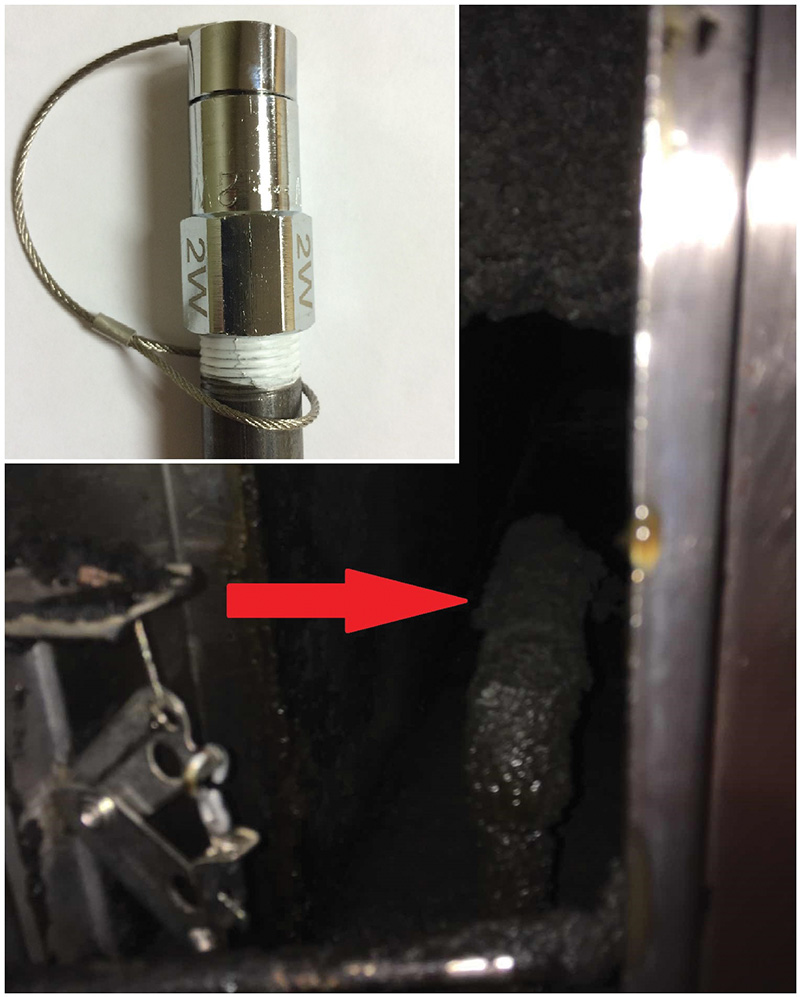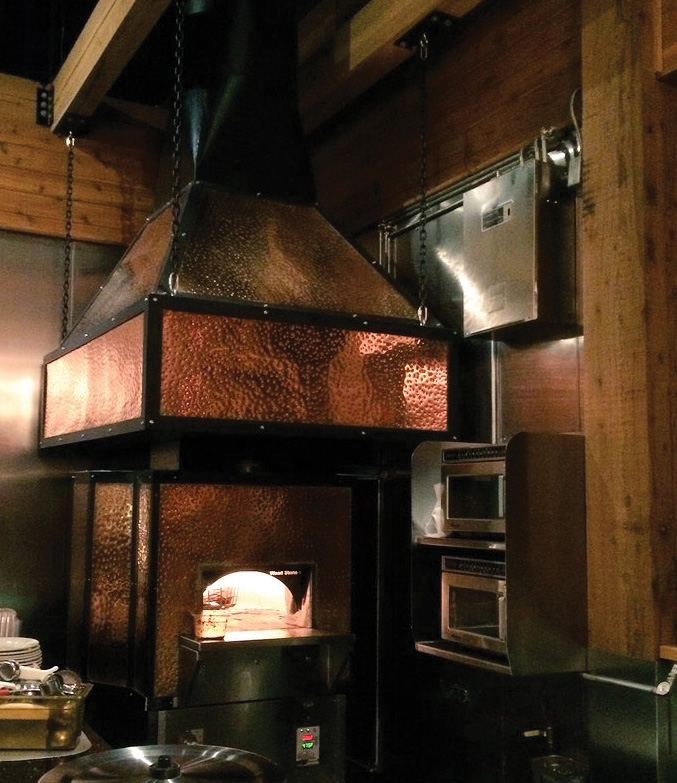Solid fuel: mitigating old hazards in new kitchens.
By Alex Garrote
Is wood-fired cooking a trend? Perhaps. According to food writer Kat Kinsman, half of the 2016 finalists for the James Beard Best New Restaurant award had wood-fired grills, and 80% featured smoky flavors on their menus. But it just doesn’t feel right to call the oldest method of cooking a trend. From Pompeiian pizza ovens to centuries-old barbecue traditions, wood fire just doesn’t feel trendy.
But with pop culture fascinated by 19th century facial hair and Prohibition-era cocktails, that historical connection may be why wood fire is thriving. Residents of buildings with central air and induction cooktops crave the lively warmth of burning wood — and restaurants are eager to provide it. Rather than simple open-air pits or stand-alone clay ovens, these restaurants use modern wood-fired appliances to harness the primal and unpredictable nature of burning wood. While this equipment is built to safely enhance the dining experience, fire safety can become complicated anytime solid fuel is burned inside of a building.
Additional Hazards
Grease fires are common, volatile, and difficult to extinguish, so standard commercial kitchen fire protection measures were designed with this hazard in mind. Regardless of the type of cooking performed, many foods release oils and grease-laden vapors that can accumulate in appliances and ventilation systems. This accumulated grease, cooking oil and the fuel used to heat appliances are what hood fire suppression systems are designed to best handle. When activated, these systems cut gas and electricity to appliances and emit a soapy chemical that reacts with hot grease to effectively smother a fire. Additionally, regular hood cleaning removes grease accumulation, thereby decreasing the fuel load available to a fire.
 Solid fuel cooking, on the other hand, poses some additional hazards that aren’t as easily mitigated by standard means. One hazard is the fact that in addition to grease, solid-fuel burning causes creosote to build up on appliances and in hoods and ducts. This is the same crumbly, sooty material that accumulates inside of the chimneys of wood-burning fireplaces, and it poses a substantial fire hazard. Creosote only needs to reach 165°F for a single spark to set it ablaze, making it easy for a duct fire to occur above appliances that typically operate at temperatures much higher than that.
Solid fuel cooking, on the other hand, poses some additional hazards that aren’t as easily mitigated by standard means. One hazard is the fact that in addition to grease, solid-fuel burning causes creosote to build up on appliances and in hoods and ducts. This is the same crumbly, sooty material that accumulates inside of the chimneys of wood-burning fireplaces, and it poses a substantial fire hazard. Creosote only needs to reach 165°F for a single spark to set it ablaze, making it easy for a duct fire to occur above appliances that typically operate at temperatures much higher than that.
The spark needed to set creosote on fire isn’t tough to find in a wood-burning kitchen. A summer night spent staring into a campfire will demonstrate the potential for flaming embers to travel remarkable distances. In a kitchen, these floating embers can easily cause a chimney fire, and the number of roof fires caused by embers making their way out of exhaust ducts may surprise you. Poorly maintained exhaust fans often result in rooftops coated in a flammable time bomb of grease and creosote, just waiting for a spark to set it off.
The tenacity with which embers burn is also evident in larger pieces of wood and charcoal. Solid fuel is tough to extinguish; it can smolder internally for hours even without much oxygen. This means that unlike gas and electricity, there’s no “on/off” switch for solid fuel, making it much harder to cool appliances that catch fire. Additionally, smoldering fuel releases flammable gases and can serve as a heat source, increasing the probability of re-ignition.
Making Maintenance Your Mantra
Being aware of the hazards posed by solid-fuel cooking is important, it drives home the need to take extra care when including this type of cooking in a kitchen. NFPA 96 is the National Fire Protection Association’s standard for commercial cooking ventilation and fire protection, and it includes an entire chapter on how to properly handle solid-fuel cooking. It is adopted as code throughout much of North America, and even in areas where it is not code it’s recognized as providing best practices for addressing solid-fuel cooking hazards. Some of the practices presented by NFPA 96 are given below, but always consult your local fire official to find out what is required for compliance in your jurisdiction before making any changes to your cooking operation.
Ventilation
Proper ventilation is the first key to establishing a safe and successful solid-fuel cooking operation — and can be the costliest. NFPA 96 requires solid fuel cooking to be done under a dedicated ventilation system that only vents solid-fuel burning appliances, and contains spark-arrestor filters to prevent embers from reaching the exhaust duct. Typically this means you can’t just buy a wood-fired grill and slap it under the hood next to your gas-fired range, you must have separate hoods and ducts for the range and grill. One way around this can be to use a very specific type of appliance that only contains a small amount of wood for flavoring food, but actually uses gas or electricity to cook. As always, check with your fire code official before investing in any changes.
 Most conventional hood fire suppression systems aren’t intended to extinguish large amounts of solid fuel; they typically are limited to relatively small quantities. Therefore, NFPA 96 requires water to be available for extinguishing fires, and for larger operations this means a standard household hose fixed to a water source. The hose must have a manually-operated nozzle that diffuses the spray of water to prevent scattering burning fuel or ashes.
Most conventional hood fire suppression systems aren’t intended to extinguish large amounts of solid fuel; they typically are limited to relatively small quantities. Therefore, NFPA 96 requires water to be available for extinguishing fires, and for larger operations this means a standard household hose fixed to a water source. The hose must have a manually-operated nozzle that diffuses the spray of water to prevent scattering burning fuel or ashes.
Maintenance
Once proper ventilation and a water supply are established, commercial kitchens operators need to make maintenance their mantra, and training a top priority. Ensure hoods are cleaned frequently. As mentioned above, creosote poses a serious fire hazard, and it accumulates rapidly in hoods and ducts. Additionally, NFPA 96 requires solid-fuel-burning appliances to be inspected and cleaned weekly. The internal flue or chimney should be cleaned if creosote begins to build up in it, and the combustion chamber of the appliance needs to be scraped to its original surface and inspected for holes and defects.
Storage & Disposal
In addition to these cleaning measures, special attention must be given to the storage and disposal of solid fuel and its byproducts. In the kitchen, ensure fuel is stored several feet away from solid-fuel burning appliances or any other heat source, and never keep more than a day’s supply near the appliance. Ash removal is also key, and needs to be done regularly (no less than once a day). Spray ashes down with water before removing them from the appliance, and dispose of them in appropriate containers that are designated for this purpose.
Given the importance of maintenance and the differences between the hazards of wood-fired and standard cooking, regular training and re-training are absolutely imperative to safety. Instruct your employees on the “why” of the sometimes labor-intensive measures they need to take — the seriousness of the fire hazard they are helping to mitigate can’t be understated. Additionally, the hose that’s intended for use on solid fuel equipment could cause disaster if used to fight a fryer fire. Make sure this is clear, and hold fire drills to ensure they are prepared to properly address small fires that may erupt in the kitchen.
The flavors and aromas of wood-fired cooking have the ability to transport diners to a different place and time, and this has made it more popular now than in years. While it comes with its risks, taking adequate safety measures will ensure the well-being of staff and patrons, and the peace of mind of the restaurateur. Through proper ventilation, fire protection, maintenance and training, this ancient cooking method can be a welcome addition to the modern restaurant kitchen.
— Alex Garrote is a restaurant fire protection specialist at Cleveland-based ABCO Fire Protection. Email Garrote at [email protected]. Follow him on Twitter at @RestaurantFire.
